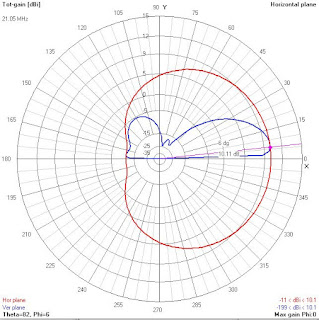Last year during CQWW SSB (Oct 2020), I had tried to tune my own designed triband VDA antenna. Whatever I tried, it seemed that antenna was not tuning or getting out well. Youtube video on that effort is at https://youtu.be/tJb-NoXO6V0
Couple of months ago, I was pondering about the issue with VDA and realized that my design was not considering PVC jacket dielectric loading (velocity factor). That made me to load the model(4NEC2) with PVC jacket and check once again with same dimension. Oh. My.. Yes, I was way too off from the design frequency and no matter what I did on ground, it would not have given right results.
So, a month back during Covid19 native place stay, I carried the VDA to be installed at my garden and check with PVC adjusted dimensions. And I was finding the spot on tuning. I know, triband on a single pole is compromise due to spacing requirements and height above the ground etc. But this is something I could live when Sea is washing its base, when I travel solo etc.
With this test done at home, I got opportunity to test it right on the beach when I was invited me to operate at Kapu Lighthouse AT8KLH near my hometown. It is a week long activation of lighthouse with many events and teams planning to operate from the location. I did quick recce of the place on my way to Udupi where I had kept most of the cables and poles from last WPX contest. Found very friendly neighborhood and a school on the beach next to lighthouse - very ideal for the operating. There is greater collective story to be compiled once the activation is complete. I am sharing my short 2 day participation experience with VDA.
Putting any antenna on beach during monsoon season is bit of pain, we took 2-3 hours to just put the antenna and secure with guy due to heavy rains. Once it was erected with help of Lakshminidhi VU2WFN, SWR plots were checked to be on CW portion of the band where myself and VU2VTI Murthy wanted to operate. Though I had carried some heavy filters etc. to operate multi, we could not due to lack of electric power at the premise.
Anyone who has operated the VDA from right on the water edge know how signals come. I can make a quick contrast with eating food right out of frying pan (still sizzling) vs somewhat cold but still fresh on the table Hi Hi!. Signals with incredibly low noise and crisp right out of the operator's shack on the other side of the globe. We made a 650+ QSOs with many breaks and change of operators etc. till we closed later evening on 15th. Epitome of thrill when one could be in the center of massive pileup and in control of it!.
Following is the 4nec2(freeware) design file if someone is interested in replicating/improvising.
https://drive.google.com/file/d/155F-yHVCxiO9XVuinu8rqDsIFrOxilXo/view?usp=sharing
There is lot of opportunity to optimize further especially for F/B ratio. Here are some plots from 4NEC2
Note: This VDA requires 10mtr tall support (I used 12mtr spider pole with last two segments collapsed). At the Cross section, I used a cutting board material with drilled holes for wire ties. For cross arms (total length of 2 meter), I could have used PVC pipes, but I had couple of Caperlan fishing rods (1 meter collapsed length). This antenna did not hear anything from back. Just to note, there was a small ridge (15ft tall) at the back side towards south east/east. which might have helped in reducing noise/signals from back. Following reverse beacon report and QSO stats shall summarize the efforts well.











